Last Updated on June 8, 2023 by Admin

Briefly describe the ways that each of the major learning theories (behaviorist, cognitive
- Briefly describe the ways that each of the major learning theories (behaviorist, cognitive, social learning, psychodynamic, and humanist) can be used to increase a behavior. Then, briefly describe the ways that each of these major theories can be used to decrease or extinguish a behavior.
- How can the learning theories be used in combination to change behavior and enhance learning?
- Discuss the following scenarios:
- You are a staff nurse preceptor, and you find that the nurse orientee you are working with has difficulty understanding the idea of titrating drug dosages on the basis of physiologic data. A weakness in which type(s) of learning might be underlying this problem? In addressing this orientee’s difficulty, what other information would you collect?
- You are preparing to counsel a nursing student who is failing a nursing course: How would your approach differ if you based your counseling on the Self-Efficacy Theory versus the Attribution Theory?
- You are a clinical preceptor in a health care agency, how can the Social Cognitive Theory assist you in teaching your preceptee?
Assignment Expectations
Length: 6-7 minute video; answers must thoroughly address the prompts and scenarios in a clear, concise manner.
Structure: Include an introduction and summary.
Prompts: Describe the learning theories: behaviorist, cognitive, social learning, psychodynamic, and humanist and how they can be used to 1) can be used to increase a behavior, and 2) can be used to decrease a behavior.
References: N/A
Format: Save your assignment as a .mp4 or provide the link to the video on YouTube.
File name: Name your saved file according to your first initial, last name, and the module number (for example, “RHall Module 1.docx”)
M1 Assignment UMBO – 2, 4, 5
M1 Assignment PLG –1, 4,9
M1 Assignment CLO – 1, 5
Expert Answer and Explanation
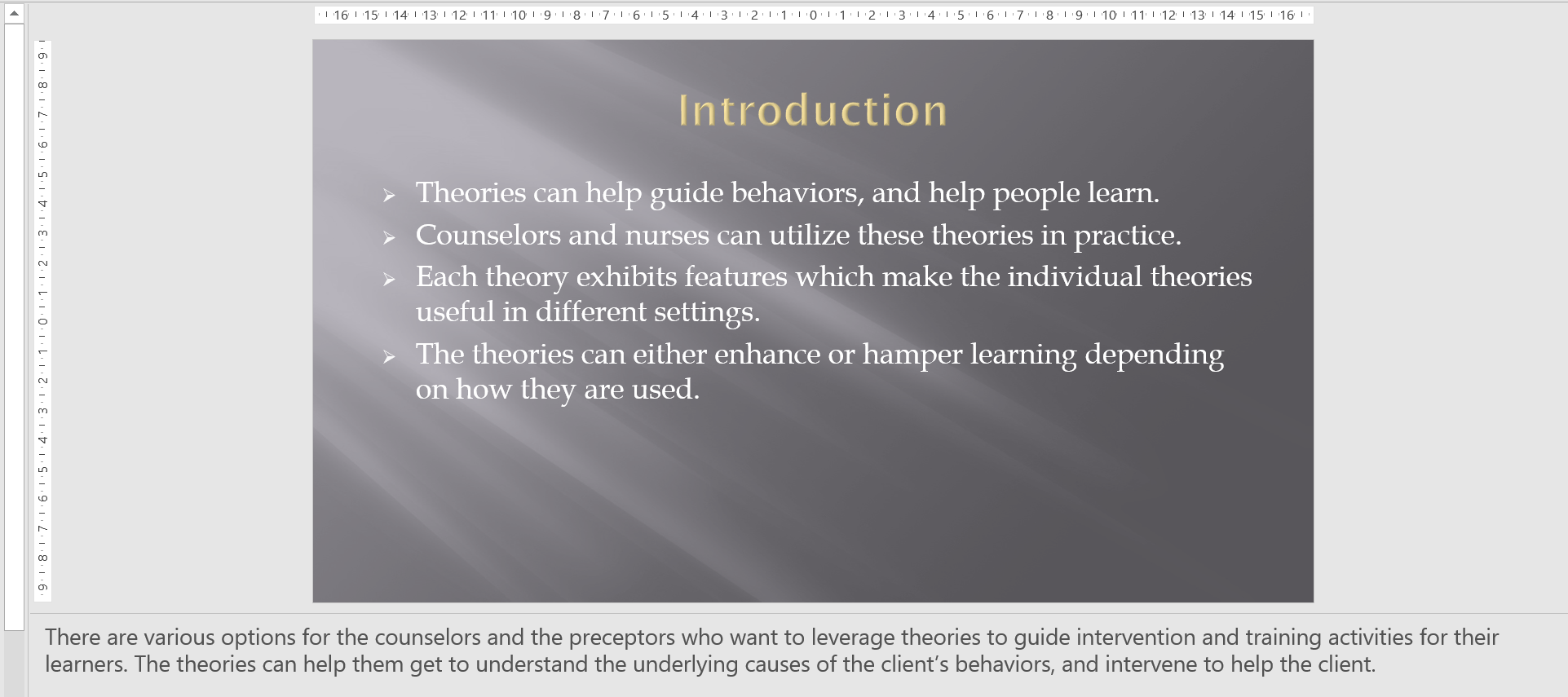
There are various options for the counselors and the preceptors who want to leverage theories to guide intervention and training activities for their learners. The theories can help them get to understand the underlying causes of the client’s behaviors, and intervene to help the client.
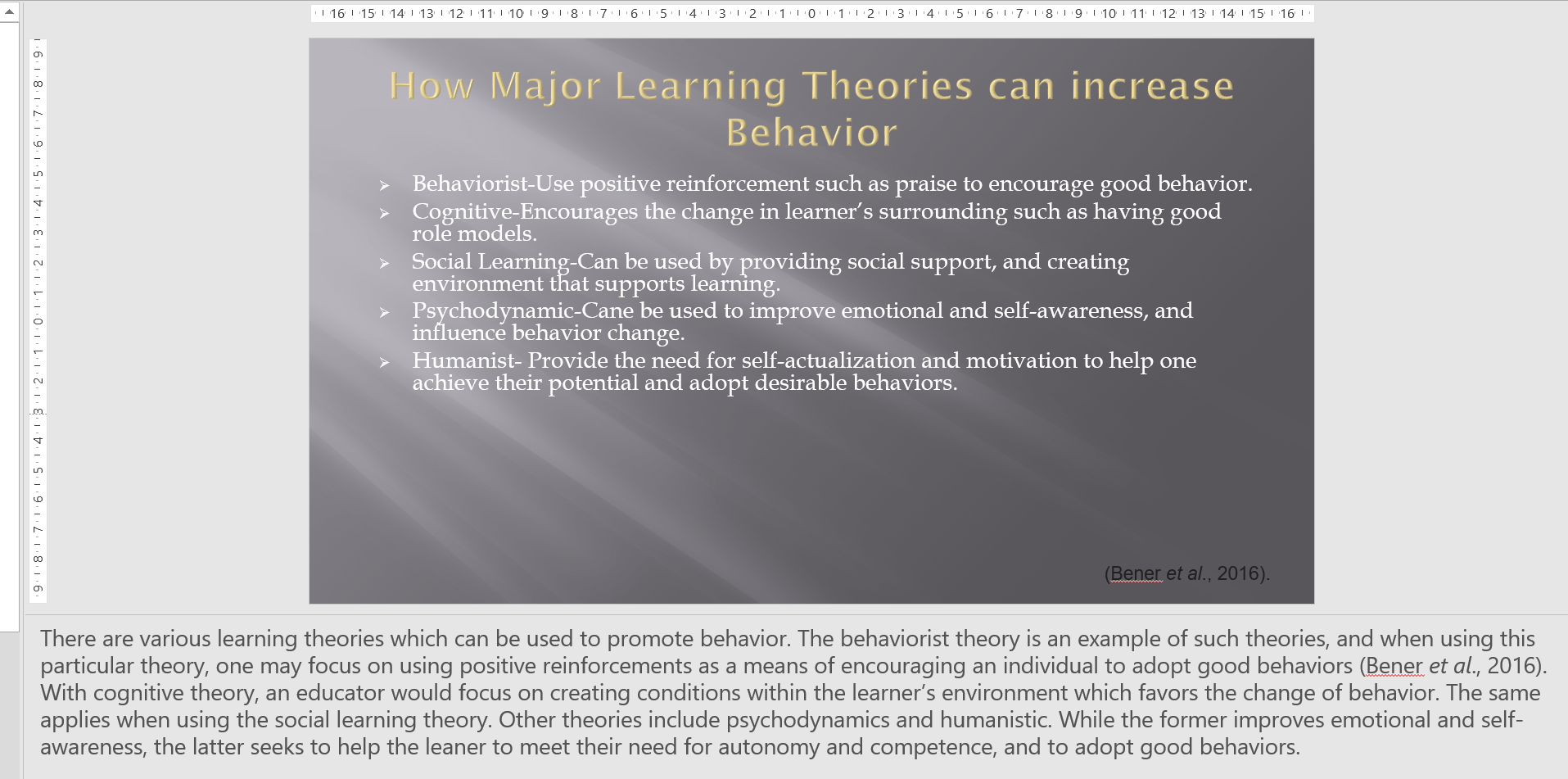
There are various learning theories which can be used to promote behavior. The behaviorist theory is an example of such theories, and when using this particular theory, one may focus on using positive reinforcements as a means of encouraging an individual to adopt good behaviors (Bener et al., 2016). With cognitive theory, an educator would focus on creating conditions within the learner’s environment which favors the change of behavior. The same applies when using the social learning theory. Other theories include psychodynamics and humanistic. While the former improves emotional and self-awareness, the latter seeks to help the leaner to meet their need for autonomy and competence, and to adopt good behaviors.

Although the theories can be useful in learning, they can hamper learning to a certain degree. For example, applying the behaviorism by banning students from attending classes on the ground that they failed to follow class rules, can worsen their performance by missing out on coursework. Similarly, removing the role models from a learner’s life, can put them at risk of developing undesirable behaviors (Gershman et al., 2016).
Using the social learning theory, a psychologist may expose the learner to unfavorable conditions which may have negative impact on learning. Considering that the Psychodynamic does not address the biological factors which affect behavior, it may encourage bead behavior among individuals.
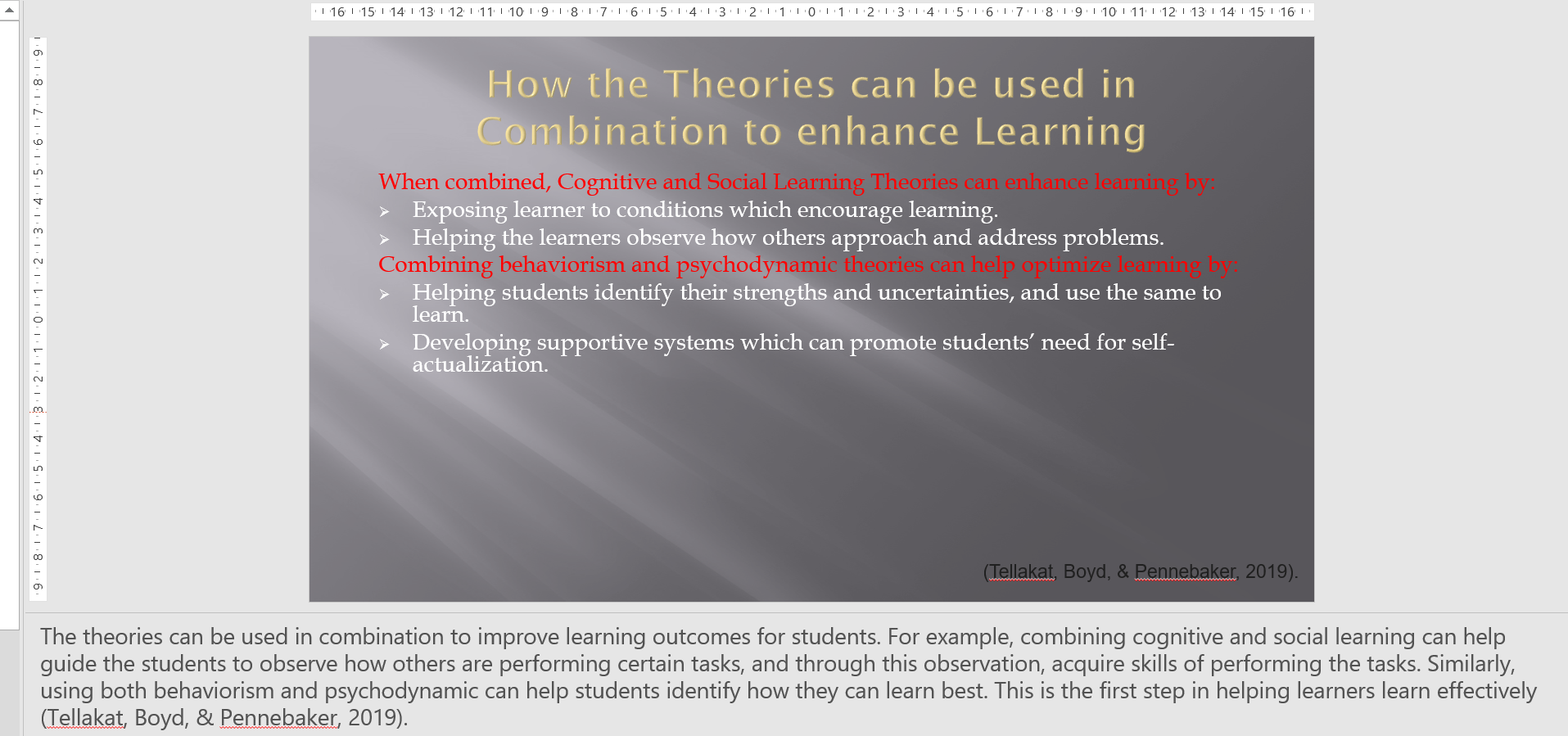
The theories can be used in combination to improve learning outcomes for students. For example, combining cognitive and social learning can help guide the students to observe how others are performing certain tasks, and through this observation, acquire skills of performing the tasks. Similarly, using both behaviorism and psychodynamic can help students identify how they can learn best. This is the first step in helping learners learn effectively (Tellakat, Boyd, & Pennebaker, 2019).
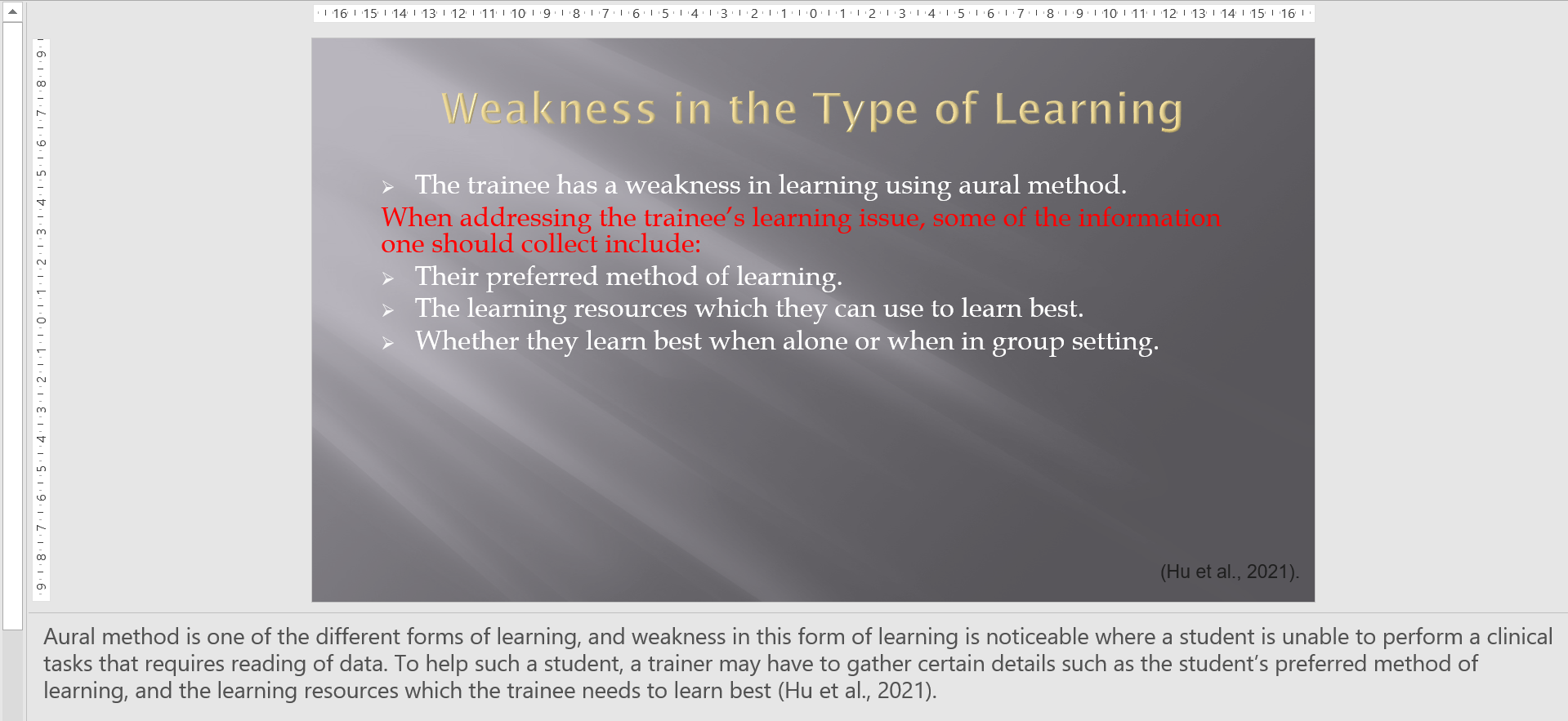
Aural method is one of the different forms of learning, and weakness in this form of learning is noticeable where a student is unable to perform a clinical tasks that requires reading of data. To help such a student, a trainer may have to gather certain details such as the student’s preferred method of learning, and the learning resources which the trainee needs to learn best (Hu et al., 2021).
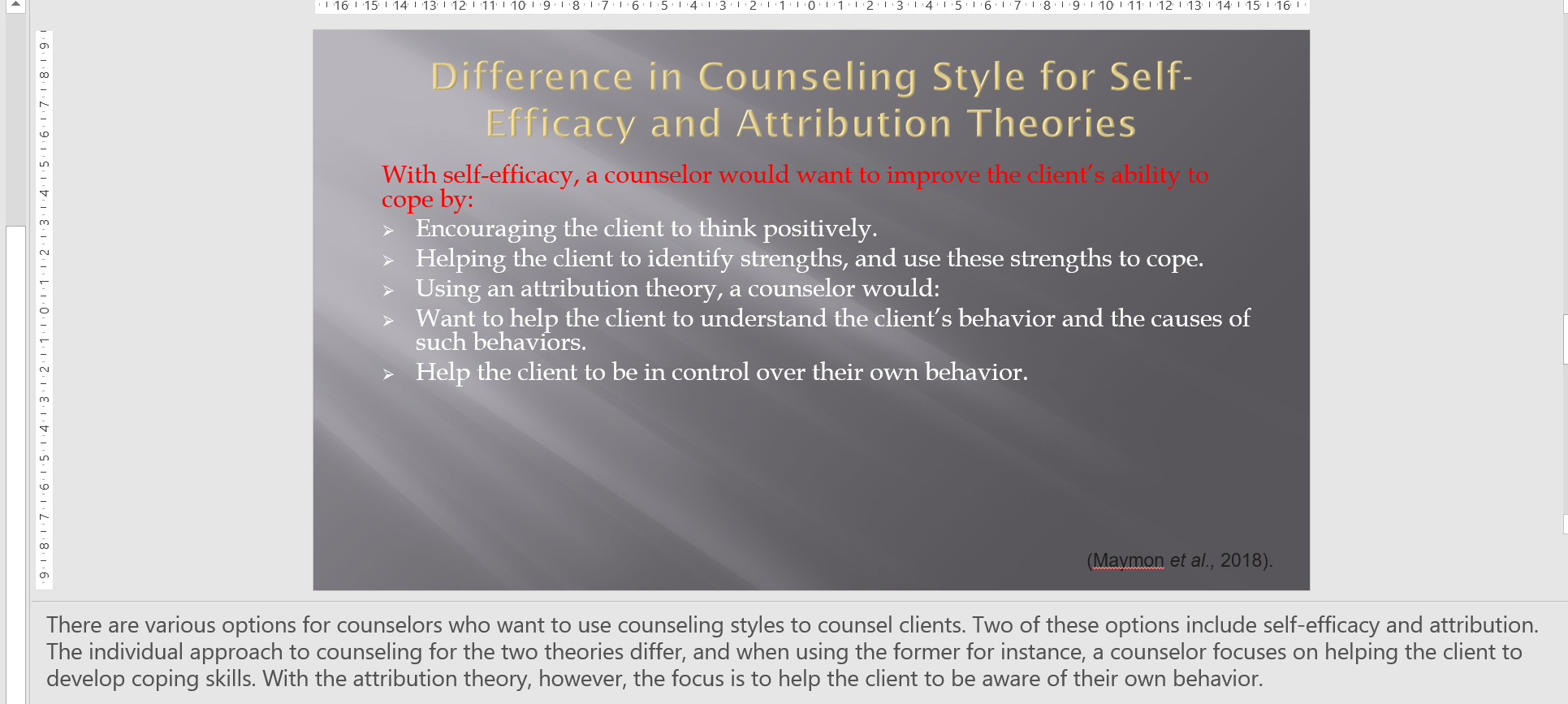
There are various options for counselors who want to use counseling styles to counsel clients. Two of these options include self-efficacy and attribution. The individual approach to counseling for the two theories differ, and when using the former for instance, a counselor focuses on helping the client to develop coping skills. With the attribution theory, however, the focus is to help the client to be aware of their own behavior.
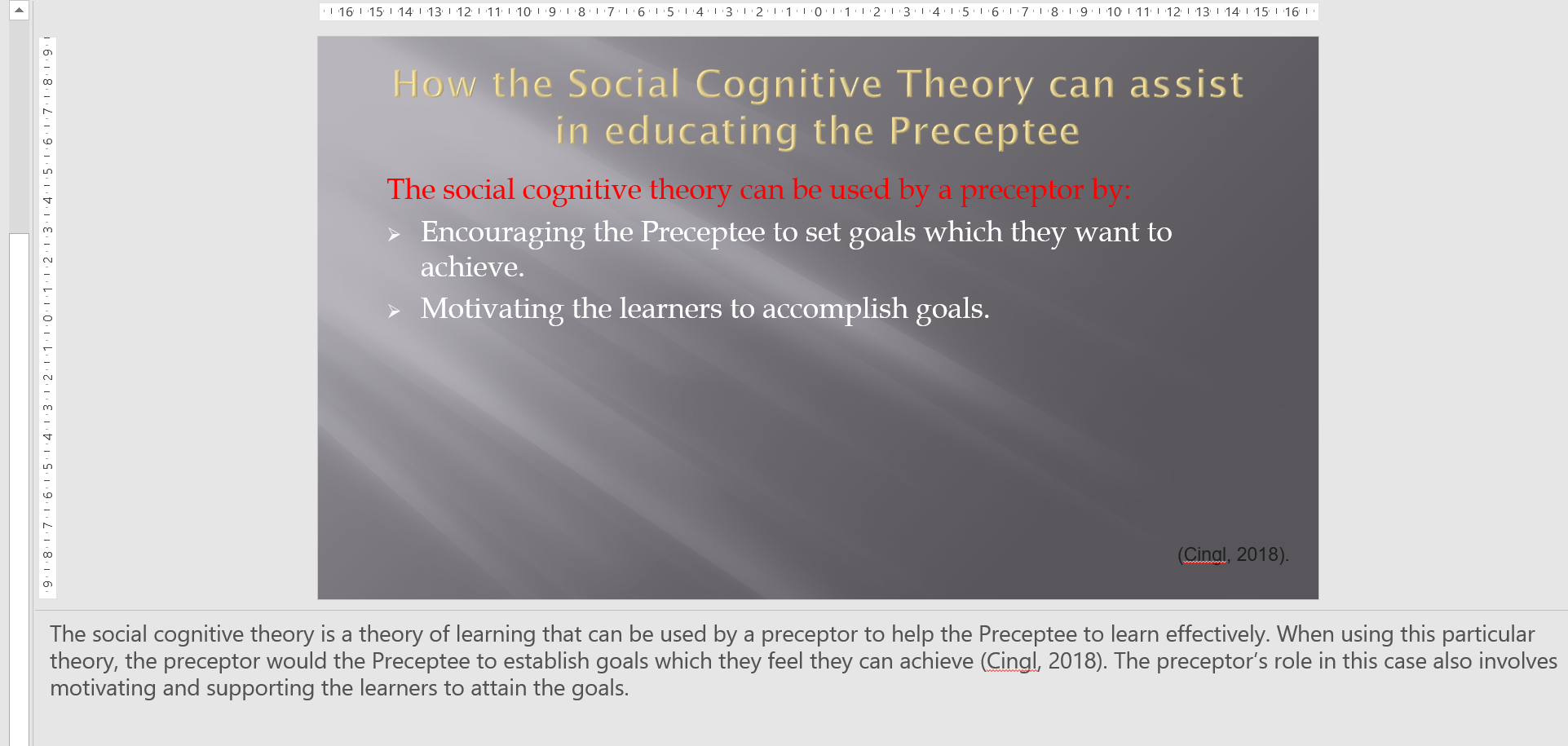
The social cognitive theory is a theory of learning that can be used by a preceptor to help the Preceptee to learn effectively. When using this particular theory, the preceptor would the Preceptee to establish goals which they feel they can achieve (Cingl, 2018). The preceptor’s role in this case also involves motivating and supporting the learners to attain the goals.
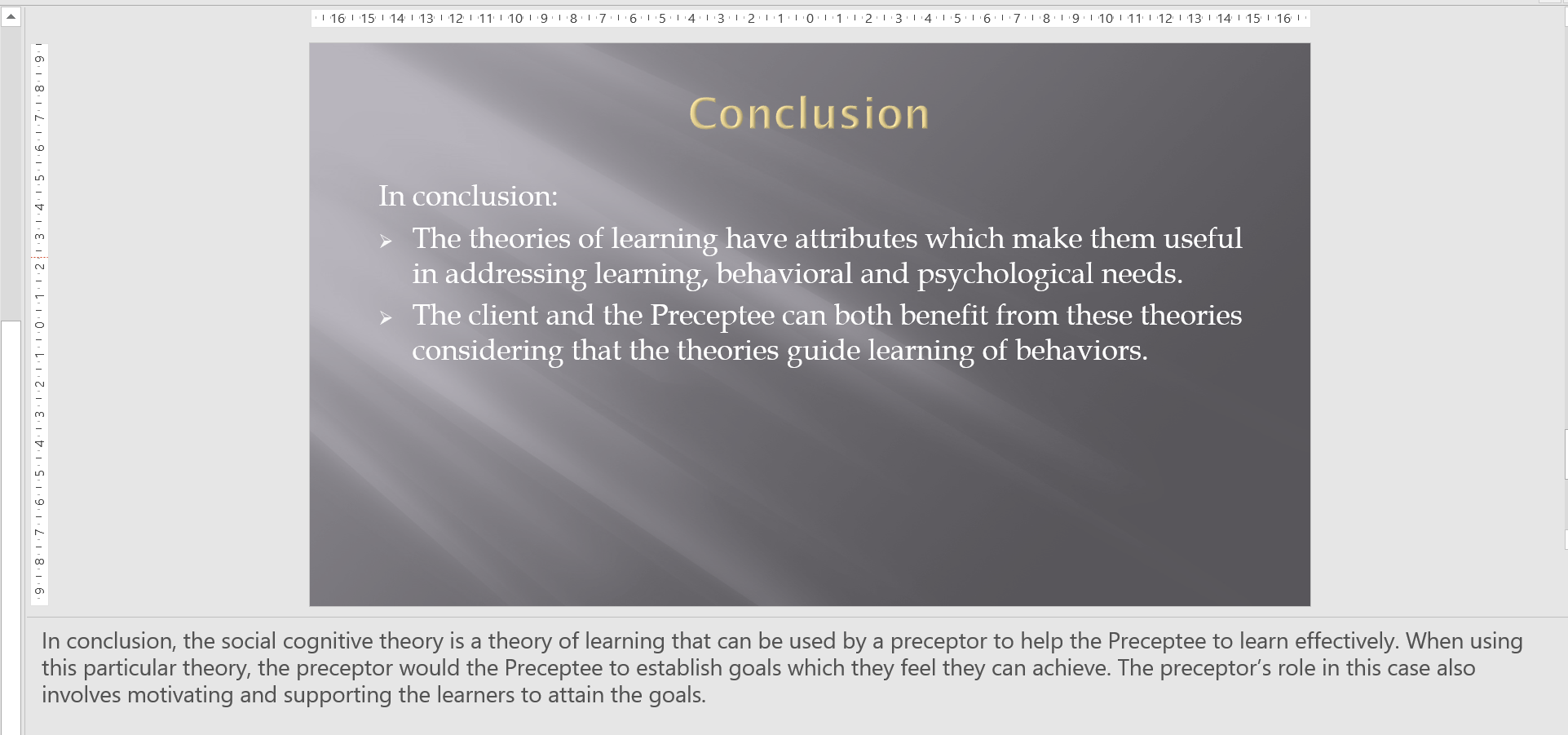
In conclusion, the social cognitive theory is a theory of learning that can be used by a preceptor to help the Preceptee to learn effectively. When using this particular theory, the preceptor would the Preceptee to establish goals which they feel they can achieve. The preceptor’s role in this case also involves motivating and supporting the learners to attain the goals.
References
Bener, A.B., Çağlayan, B., Henry, A.D., & Prałat, P. (2016). Empirical Models of Social Learning in a Large, Evolving Network. PLoS ONE 11(10). e0160307.Doi: https://doi.org/10.1371/journal.pone.0160307.
Cingl, L. (2018). Social learning under acute stress. PLoS ONE 13(8). e0202335. Doi :https://doi.org/10.1371/journal.pone.0202335.
Gershman, S.J., Gerstenberg, T., Baker, C.L., & Cushman, F.A. (2016). Plans, Habits, and Theory of Mind. PLoS ONE 11(9). e0162246. Doi: https://doi.org/10.1371/journal.pone.0162246.
Hu, J., Peng, Y., Chen, X., & Yu, H. (2021). Differentiating the learning styles of college students in different disciplines in a college English blended learning setting. PLoS ONE 16(5). e0251545. Doi:https://doi.org/10.1371/journal.pone.0251545.
Maymon, R., Hal,l N.C., Goetz, T., Chiarella, A., & Rahimi, S. (2018). Technology, attributions, and emotions in post-secondary education: An application of Weiner’s attribution theory to academic computing problems. PLoS ONE 13(3). e0193443. Doi: https://doi.org/10.1371/journal.pone.0193443.
Tellakat, M., Boyd, R.L., & Pennebaker, J.W. (2019). How do online learners study? The psychometrics of students’ clicking patterns in online courses. PLoS ONE 14(3). e0213863. Doi:https://doi.org/10.1371/journal.pone.0213863.
Use Coupon Code: NEW30 to Get 30% OFF Your First Order
Related Answered Questions
[SOLVED] Sabrina is a 26 year old female who has just been
SOLVED! An 83-year-old resident of a skilled nursing
SOLVED!! Describe the clinical manifestations present in
What are some strategies you can use to help clients
SOLVED!! Develop 3–4 new SMART goals for this quarter and
[ANSWERED] What is the significance of the product lifecycle
ANSWERED! In this project you will select an organization or
Understanding Cognitive Learning Theory: Unlocking the Secrets of Effective Knowledge Acquisition
In today’s information-driven world, the ability to learn and acquire knowledge efficiently is crucial for personal and professional growth. One prominent theory that sheds light on the cognitive processes underlying learning is the cognitive learning theory. Developed by renowned psychologists, this theory provides valuable insights into how individuals perceive, process, store, and retrieve information. In this comprehensive article, we delve into the depths of cognitive learning theory, exploring its core principles, applications, and practical tips for optimizing the learning experience.
What is Cognitive Learning Theory?
Cognitive learning theory, rooted in the field of cognitive psychology, emphasizes the role of mental processes in acquiring, organizing, and using knowledge. According to this theory, learning is an active process where individuals construct their understanding by assimilating new information into their existing mental frameworks, known as schemas. It suggests that learning occurs through various cognitive processes, such as attention, perception, memory, and problem-solving.
The Core Principles of Cognitive Learning Theory
1. Attention and Perception
Attention plays a pivotal role in the cognitive learning process. Individuals direct their focus toward relevant stimuli and filter out distractions. By engaging in selective attention, learners allocate their mental resources to comprehend and retain information effectively. Additionally, perception, the interpretation of sensory information, influences how individuals encode and make sense of the world around them. Understanding the mechanisms of attention and perception can help optimize instructional strategies and create engaging learning environments.
2. Memory Encoding and Retrieval
Memory is a fundamental aspect of learning, and cognitive learning theory offers valuable insights into how memories are encoded and retrieved. Encoding refers to the process of transforming information into a memory representation, while retrieval involves accessing and utilizing that information when needed. Strategies such as repetition, elaboration, and chunking can enhance memory encoding and retrieval, enabling learners to recall information more accurately and efficiently.
3. Information Processing and Organization
Cognitive learning theory highlights the importance of effective information processing and organization in facilitating learning. It suggests that learners actively construct meaning by organizing and categorizing new information based on their existing knowledge structures. By relating new concepts to prior knowledge, individuals can create meaningful connections and facilitate long-term retention. Employing techniques like concept mapping, note-taking, and summarization can promote effective information processing and organization.
4. Problem-Solving and Critical Thinking
The ability to solve problems and think critically is a fundamental skill in cognitive learning theory. It emphasizes the importance of fostering learners’ analytical and problem-solving abilities by providing opportunities for active engagement and reflection. By presenting challenging tasks and encouraging exploration, educators can promote higher-order thinking skills and empower learners to apply their knowledge in real-world contexts.
Applications of Cognitive Learning Theory
Cognitive learning theory has significant implications across various domains, including education, training, and instructional design. Understanding and applying its principles can lead to the development of more effective teaching methods and learning environments. Here are a few practical applications:
1. Personalized Learning Environments
By recognizing the individual differences in learners’ cognitive processes, educators can create personalized learning environments that cater to diverse needs and preferences. Adaptive learning technologies, for instance, utilize cognitive learning theory to deliver customized instruction based on learners’ performance and progress.
2. Multimedia Learning
Cognitive learning theory suggests that presenting information through multiple sensory channels enhances learning outcomes. Integrating multimedia elements, such as visuals, audio, and interactive components, into instructional materials can promote deeper understanding and retention of information.
3. Metacognitive Strategies
Metacognition refers to the awareness and regulation of one’s own thinking processes. Teaching metacognitive strategies, such as self-reflection, goal-setting, and self-monitoring, can enhance learners’ ability to plan, monitor, and evaluate their learning progress effectively.
4. Problem-Based Learning
Problem-based learning approaches align well with cognitive learning theory by emphasizing active engagement and problem-solving. This instructional method encourages learners to tackle real-world problems, promoting critical thinking, collaboration, and the application of acquired knowledge.
Optimizing the Learning Experience
To optimize the learning experience based on cognitive learning theory, consider implementing the following strategies:
- Engage Learners Actively: Encourage active participation through discussions, hands-on activities, and interactive exercises that promote higher-order thinking skills.
- Provide Clear Instructional Guidance: Clearly communicate learning objectives, provide explicit instructions, and offer scaffolding to support learners in acquiring new knowledge and skills.
- Offer Timely Feedback: Provide constructive feedback to learners, highlighting areas of improvement and guiding them toward self-reflection and self-correction.
- Promote Collaboration: Foster a collaborative learning environment where learners can engage in discussions, peer feedback, and cooperative tasks that promote knowledge construction and social interaction.
- Create Meaningful Contexts: Relate new information to real-world contexts and personal experiences to enhance understanding and promote transfer of knowledge.
- Utilize Varied Assessment Methods: Employ diverse assessment methods, including formative and summative assessments, to evaluate learners’ progress and understanding effectively.
By applying these strategies informed by cognitive learning theory, you can create an optimal learning experience that enhances knowledge acquisition, retention, and application.
Behavioral, Humanistic, and Cognitive Approaches: Exploring the Differences and Similarities
In the field of psychology, multiple theoretical perspectives provide distinct lenses through which human behavior and mental processes can be understood. Three prominent approaches are the behavioral, humanistic, and cognitive approaches. While each approach offers unique insights, they also share commonalities in their focus on understanding human functioning. In this article, we compare and contrast these approaches, highlighting their key principles, methodologies, and contributions to the field of psychology.
Behavioral, Humanistic, and Cognitive Approaches: Exploring the Differences and Similarities
In the field of psychology, multiple theoretical perspectives provide distinct lenses through which human behavior and mental processes can be understood. Three prominent approaches are the behavioral, humanistic, and cognitive approaches. While each approach offers unique insights, they also share commonalities in their focus on understanding human functioning. In this article, we compare and contrast these approaches, highlighting their key principles, methodologies, and contributions to the field of psychology.
Behavioral Approach
The behavioral approach, also known as behaviorism, emerged as a dominant psychological perspective in the early 20th century. It emphasizes observable behaviors and external stimuli as the primary focus of investigation. Key proponents of behaviorism include John B. Watson, B.F. Skinner, and Ivan Pavlov. Here are some important characteristics of the behavioral approach:
Principles and Focus:
- Stimulus-Response (S-R) Associations: Behaviorists propose that behavior is learned through associations between stimuli and responses. They focus on understanding how external factors influence behavior and how individuals respond to specific environmental stimuli.
- Conditioning: Behaviorists emphasize the role of conditioning processes in behavior formation. Two forms of conditioning are prominent: classical conditioning, where an individual learns to associate a neutral stimulus with a specific response, and operant conditioning, where behavior is shaped through reinforcement and punishment.
Methodologies:
- Experimental Methods: Behaviorists heavily rely on laboratory experiments to study behavior. They manipulate variables and observe how changes in stimuli lead to changes in behavior. This approach allows for controlled studies to establish causal relationships between stimuli and responses.
- Quantitative Data Analysis: Behaviorists often employ quantitative methods to analyze data, using statistical techniques to measure and quantify behavior, such as response rates, reaction times, and frequency of occurrence.
Contributions:
- Behavior Modification: The behavioral approach has significantly influenced therapeutic interventions by promoting behavior modification techniques. Techniques such as systematic desensitization, token economies, and aversion therapy have been developed based on behaviorist principles.
- Learning Theories: Behaviorism has contributed to our understanding of how individuals acquire new behaviors and extinguish existing ones. The principles of classical and operant conditioning are widely applied in education, training, and behavior management.
Humanistic Approach
The humanistic approach emerged as a reaction to the deterministic and reductionist views of behaviorism and psychoanalysis. Proponents such as Carl Rogers and Abraham Maslow emphasized human potential, subjective experiences, and personal growth. Here are the key characteristics of the humanistic approach:
Principles and Focus:
- Self-Actualization: Humanists believe that individuals have an innate drive for self-actualization, the realization of their highest potential. They emphasize personal growth, self-awareness, and self-improvement as central aspects of human functioning.
- Subjective Experiences: Humanists focus on individuals’ subjective experiences, including emotions, thoughts, and perceptions. They believe that understanding these subjective experiences is crucial for comprehending human behavior.
Methodologies:
- Qualitative Methods: Humanistic psychologists often utilize qualitative methods, such as interviews, case studies, and subjective self-report measures, to capture the richness and depth of individuals’ subjective experiences. These methods allow for a deeper understanding of the individual’s unique perspective.
- Person-Centered Approach: Humanistic therapists employ a person-centered approach, emphasizing empathy, unconditional positive regard, and active listening. This therapeutic approach aims to facilitate self-discovery and personal growth by creating a supportive and non-judgmental therapeutic environment.
Contributions:
- Positive Psychology: The humanistic approach has influenced the development of positive psychology, which focuses on understanding and promoting well-being, resilience, and flourishing in individuals and communities.
- Client-Centered Therapy: Humanistic principles have contributed to the development of client-centered therapy, a therapeutic approach that emphasizes the therapist-client relationship and the client’s autonomy in their own therapeutic process.
Cognitive Approach
The cognitive approach gained prominence in the mid-20th century, shifting the focus from observable behavior to internal mental processes. It explores how individuals perceive, process, and interpret information from their environment. Key contributors to the cognitive approach include Jean Piaget, Albert Bandura, and Ulric Neisser. Let’s delve into the characteristics of the cognitive approach:
Principles and Focus:
- Information Processing: The cognitive approach views the mind as an information-processing system, where individuals actively engage in processes such as attention, memory, perception, and problem-solving. It focuses on understanding how these processes shape human behavior.
- Internal Mental Representations: Cognitive psychologists emphasize the importance of mental representations, such as schemas, beliefs, and expectations, in influencing individuals’ thoughts, feelings, and actions.
Methodologies:
- Experimental and Observational Methods: Cognitive psychologists employ experimental methods to investigate mental processes. They use tasks, such as memory experiments and problem-solving tasks, to examine cognitive processes and the factors that influence them. Observational methods are also used to study naturalistic behaviors and cognitive functioning.
- Mixed Methods: The cognitive approach incorporates both qualitative and quantitative methods. While experiments provide controlled conditions, qualitative techniques, such as think-aloud protocols and interviews, offer insights into individuals’ thought processes.
Contributions:
- Cognitive-Behavioral Therapy (CBT): The cognitive approach has had a significant impact on psychotherapy, leading to the development of cognitive-behavioral therapy (CBT). CBT focuses on identifying and modifying maladaptive thoughts and beliefs to promote healthier behaviors and emotional well-being.
- Information Processing Models: Cognitive psychologists have developed models that explain how individuals process and store information, such as the Atkinson-Shiffrin model of memory and the information processing model of problem-solving. These models have advanced our understanding of human cognition.
Comparisons and Contrasts
While the behavioral, humanistic, and cognitive approaches differ in their fundamental principles and methodologies, they also share some commonalities:
- Focus on Individual Differences: All three approaches recognize the uniqueness of individuals and emphasize the importance of understanding individual differences in behavior and experiences.
- Application in Therapy: The behavioral, humanistic, and cognitive approaches have influenced therapeutic interventions. Behavior modification techniques, person-centered therapy, and cognitive-behavioral therapy are practical applications derived from these approaches.
- Empirical Basis: Despite their differences, each approach is grounded in empirical research and seeks to explain human behavior and cognition through systematic observations and experiments.
In summary, the behavioral, humanistic, and cognitive approaches offer distinct perspectives on human behavior and mental processes. While the behavioral approach focuses on observable behaviors and conditioning, the humanistic approach emphasizes personal growth and subjective experiences, and the cognitive approach delves into internal mental processes and information processing. Understanding the strengths and limitations of each approach provides a holistic understanding of human psychology.

